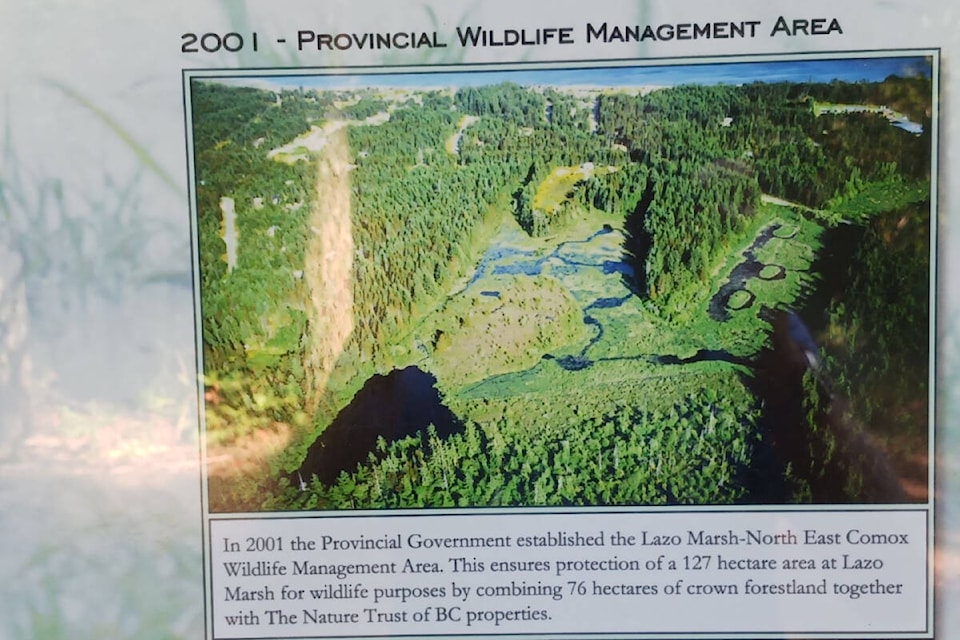Submitted by Bob Austin
Special to the Record
Some 26 years ago, we (Bob and Jane Austin) built our home on Lazo Road, alongside Lazo Marsh. Sadly, we have seen the marsh deteriorate as it has been overrun by invasive plant life which has almost eliminated waterfowl and other species, despite the efforts of Ducks Unlimited, Nature Trust and others. I made it my mission this summer to see if anything positive is being done, and the hopeful answer is “Yes”. but we shall see!
Background history
Lazo Marsh has a complex and somewhat sordid past. In the 1930s and ’40s, the marsh was drained and became a potato farm. In the 60s Bert Marrriot bought 69 hectares and he and his wife Barbara established “The Marriot Bird Sanctuary” offering guided tours of the marsh and its wildlife to the public. In 1975, Nature Trust of British Columbia purchased 34 hectares, adding 15 more in 1980. In 2001, the province established the Lazo Marsh/North East Comox Wildlife Management Area. Over the years, Lazo Marsh has been managed by Ducks Unlimited and Nature Trust. Every 10 years, the marsh has been “scarified or scraped” by a bulldozer to move aside the heavy layer of plant life and create more open water for waterfowl. The next scarification is due in 2014.
The invasion of yellow flag iris
When the marsh was drained it became an easy target for the invasion of yellow flag iris. Today, this invasive species completely dominates the marsh. All 49 hectares have been taken over by this plant which thrives in the very shallow water of the marsh. Scarification has proven ineffective as the yellow flag iris quickly re-establishes itself.
Years ago, migratory duck counts numbered more than 2m500 and in the winter Comox residents skated on the marsh. not today.
Lazo Marsh restoration
Some 10 years ago, I attended a seminar led by Tom Biebighauser, a renowned wetland specialist from Kentucky. He and a group of students were studying Lazo Marsh. Tom has restored over 2,850 wetlands in Canada, the US, Mexico, and four other countries. He was involved in the restoration of some 500 wetland areas across B.C. and Alberta since 2003. He is the author of four books on wetland restoration. I recently contacted him for his thoughts on Lazo Marsh. His comments were lengthy and very instructive,and too detailed to outline here. However, one of his primary recommendations for restoring Lazo Marsh is “restoring natural wetland basins that range up to 10,000 square meters in size and from 1-2 metres deep with gradual slopes.” The rational for these large, deep ponds is that yellow flag iris and reed canary grass cannot take root and dominate the marsh. The large open water areas are an ideal environment for waterfowl and aquatic life.
Positive developments
Mr. Biebighauser sent copies of his recommendations to Matthew Wilson, head of conservation programs for Ducks Unlimited Canada, B.C. Part of his response to Tom is… “The West Coast Conservation Land Management Program, a partnership program comprising the Nature Trust of BC, Ducks Unlimited Canada, Environment and Climate Change Canada and Ministry of Forests, is currently undertaking a comprehensive hydrologic study of the marsh. The results and recommendations from this report, as well as other land-use considerations, will help inform future management decisions at Lazo Marsh, including management and restoration actions.”
Similar sentiments were expressed Thomas Reid at Nature Trust.
“For information purposes, we are currently working to update our internal management direction statement for Lazo Marsh that will utilize a comprehensive hydrologic study to inform management decisions, including scarification moving forward…”
Hopeful conclusion
All the organizations involved in Lazo Marsh seem to be on the same page – namely conducting proper assessment and research with the goal of restoring Lazo Marsh to become once again, the valuable treasure that it once was.
